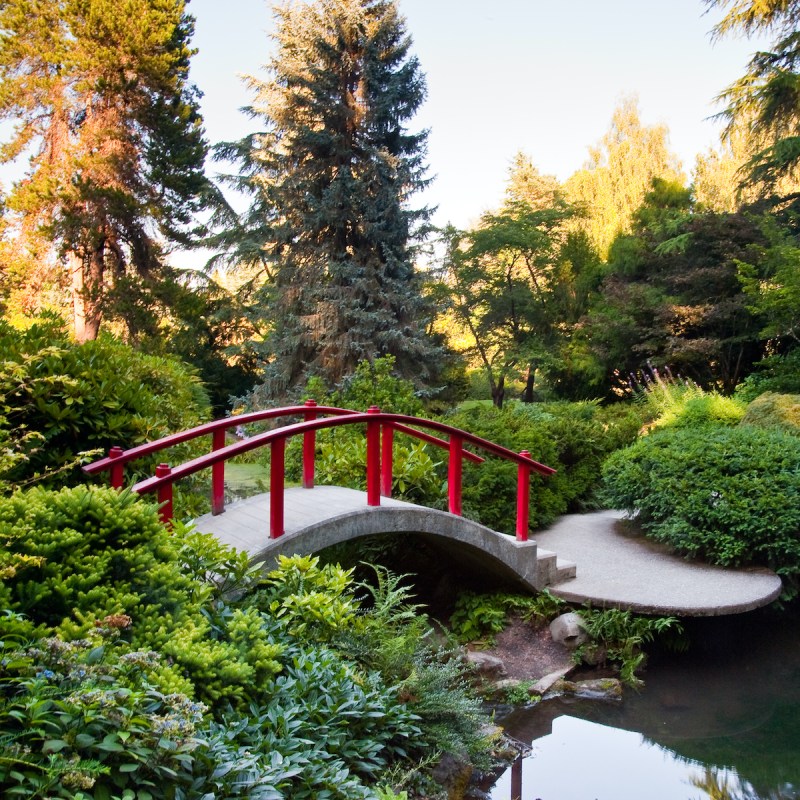
I moved to the Pacific Northwest about 10 years ago and I am still discovering gorgeous gardens here. From rhododendrons in the spring to dahlias and lavender in the summer, there is a variety of blooms to delight the senses. Visitors will find Japanese influences in many gardens in the area. Larger public gardens often have smaller Japanese gardens. Famed landscape architects Thomas Church, Richard Haag, Fujitaro Kubota, and the Olmsted Brothers influenced the design or consulted on many of these gardens.
Videos by TravelAwaits
1. Lakewold Gardens
Lakewood, Washington
In an area once roamed by the Nisqually Indians, the Lakes District became an area where the wealthy from nearby Tacoma had their summer homes. The lovely Lakewold Gardens was once a country retreat and the last owner Eulalie Wagner donated her estate to become a nonprofit public garden. At the time she said, “As we become more and more city creatures, living in manmade surroundings, perhaps gardens will become even more precious to us, letting us remember that we began in the garden.”
Rhododendrons and Japanese Maples are the main plants in the garden providing color in the spring and fall. Washington State Big Tree Program lists 1,000 trees from 800 species that are the largest in the state. Lakewold Gardens has eight of these massive trees.
Pro Tip: Make sure to visit the shop at Lakewold Gardens, which is in the original 1918 carriage house. Shoppers will find a variety of items from local artists and businesses.

2. The Bloedel Reserve
Bainbridge Island, Washington
The Bloedel Reserve is an incredible 150-acre property developed by Prentice and Virginia Bloedel. This land is the sacred ancestral territory of the Suquamish People. The Bloedels were passionate custodians, and their gardens enhance the Northwest forest on the site. There are a variety of different garden types on site, but my favorite is the Japanese Garden and the Japanese Guest House. The Sand and Stone Garden is simple but there is something so peaceful about it. Mr. Fujirtaro Kubota created the garden and it has twice been named one of the top ten Japanese gardens in the United States by the Journal of Japanese Gardening.
One thing that makes the Bloedel Reserve unique is its focus on wellness and the healing power of nature. One of the programs offered is Strolls for Well-Being, which promotes connection with nature with a series of 12 self-guided walks. Each participant receives a guidebook with instructions. There are 12 distinct self-guided walks during the program with themes such as gratitude, joy, and awareness. The program is very popular.

3. Kubota Garden
Seattle, Washington
The Kubota Garden is peaceful and well away from the hustle and bustle of Seattle. The moment visitors walk through the gate onto the 20-acre garden, a sense of peace envelops them. This began as the display garden for Fujitaro Kubota, a famed Pacific Northwest master landscaper. He blended North American plants and materials with Japanese design techniques. The garden is just stunning and a true reflection of Kubota’s skills. The rolling terrain and rock out-cropping contain 11 ponds and two red bridges that are interspersed with 140 maple and 30 hydrangea varieties. The peaceful trickle of streams and the gentle roar of the small waterfalls just beckon peaceful contemplations.
Pro Tip: Tours of the garden are self-guided but Kubota Garden Public Tours are available on the fourth Saturday of the month at 10 a.m. The tours are 2 hours long and visitors will walk 1.5 miles. Learn about the garden’s history, plants, and development of the site.

4. Rhododendron Species Botanical Garden
Federal Way, Washington
The Rhododendron Species Botanical Garden is in a Pacific Northwest Forest. Nestled among the Douglas Fir, Western Red Cedar, and Hemlock trees visitors will enjoy the largest collection of Rhododendron species in the world. In addition, the famous Himalayan Blue Poppies and many other rare plants bloom throughout the year. The garden is so natural looking it is like hiking a forest trail unlike any you have ever been to. The Victorian Stumpery is the largest stumpery in the world. This magical fairyland is filled with over 140 stumps and logs and spills over with ferns. Its purpose is to provide a habitat for ferns and shade-loving plants while also using the unique features of the wood to create a pleasing arrangement.
Pro Tip: Located next to the Rhody garden is the Pacific Bonsai Museum. Look for the exceptionally large Bonsai. With the Japanese Internment during World War II, this tree’s owner was interned and a family friend took care of the tree but had no bonsai skills. So during wartime, the tree grew until it was eventually reunited with its owner.

5. Skagit County Tulip Festival
Skagit County, Washington
The Skagit County Tulip Festival takes place each year in April. Daffodils precede the tulips and only bloom once a year. Peak season varies every year based on Mother Nature. Print off a copy of the festival map and take the driving tour throughout the county to see all the sites. Tulip fields vary each year so make sure you have this year’s map. The tulips paint a wave of color across the Skagit Valley. Take time to explore the area including the charming small towns such as La Conner. Shop for bulbs for your garden or lots of tulip-themed souvenirs.
Pro Tip: Sign up for the new Passport Program in partnership with the Skagit Tourism Bureau. Explore the Skagit Valley and earn points for prizes. Discover the tulip farms, try local activities, and enjoy lots of delicious places to eat.

6. Yakima Area Arboretum
Yakima, Washington
Spring is a great time to visit the Yakima Area Arboretum. Set on 46 acres of land alongside Interstate 82, the arboretum grounds have 30 acres of grass lawn landscaped with a variety of natural and import trees and plants in display gardens and collections. From March through May, highlights include flowering trees such as the Magnolia, Red-Osier Dogwood, Contorted Filbert, and lots of flowering bulbs, one of the first signs of spring. A highlight for me is the Joyful Garden, which is a Japanese-inspired garden. On warm days it is a peaceful shady refuge from the heat.

7. The Oregon Garden
Silverton, Oregon
Unlike the above gardens that tend to have a more natural look to them, the Oregon Garden has 20 stylized specialty gardens that highlight the botanical beauty of the Pacific Northwest. Spread out over 80 acres with more than 4 miles of ADA paths and surprisingly pet friendly. Highlights include the Bosque Garden. It has four brick reflecting ponds and 40 planter boxes with Pacific Sunset Maples. The Silverton Garden Market showcases many of the 147 crops grown in the Willamette Valley and Oregon. The Wetlands is an environmental marvel where Silverton’s wastewater is used to create a vibrant wetland. Water is terraced through a series of ponds with plants before entering a holding tank that is then used to irrigate the garden.
Pro Tip: Stay at the Oregon Garden Resort for easy access when visiting the resort. The Garden View Restaurant has large picture windows overlooking the Oregon Garden. Also book a tour of The Gordon House, Oregon’s only Frank Lloyd Wright home. The tours are small and provide a unique insight into this famous architect’s work. The home is adjacent to the Oregon Gardens sharing the same entrance.

8. Portland Japanese Garden
Portland, Oregon
The Portland Japanese Garden is the most strenuous of the gardens on this list. It is amid Washington Park, which is incredibly popular, so parking can be a challenge with a long walk before you reach the Japanese garden. A visit begins with a hike up a hill through the Entry Garden, which is a series of cascading pools with a landscaped walk up a terraced stone pathway through a lush forest. I found it challenging but doable.
The gorgeous scenery sure helped as I took quite a few photo breaks. For those with mobility issues, there is a free shuttle that will take you to the Cultural Village. This is a space to learn more about Japanese art and culture. There are a total of eight garden spaces and each one represents a unique aspect of Japanese garden history and design. This is such a tranquil and peaceful place even with all the people who visit.

9. Deepwood Museum And Gardens
Salem, Oregon
The Deepwood Museum and Gardens are located near downtown Salem. The property features a five-acre public park that has gorgeous formal gardens, many of which were designed by Lord & Schryver Landscape Design, the Northwest’s first female-owned landscape architecture firm. Their style is evident throughout the grounds. Also on site are the original carriage house, a greenhouse, and nature trails. The Deepwood historic home is open for tours and visitors must make a reservation online.

10. Wooden Shoe Tulip Farm
Woodburn, Oregon
The Wooden Shoe Tulip Farm is home to one of the most popular spring events in Oregon, the Wooden Shoe Tulip Festival. There are 40 acres of tulips for an incredible swath of color and 200 acres of outdoor space. Tickets must be purchased online to minimize the crowds. Multiple food venues are available and a well-stocked gift shop with a variety of tulip-themed items including cut flowers and potted bulbs. There is also a craft fair and a wooden shoemaker.
Pro Tip: The best way to view the tulips is with wine. Book a Farm Wine Tour. Enjoy a one-hour farm tour around the property and enjoy an estate wine tasting with pairings. It even comes with a wine traveler mug.
For more information on traveling to the Pacific Northwest, check out these articles:
